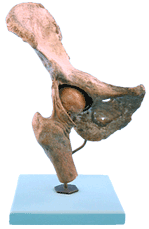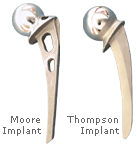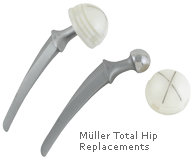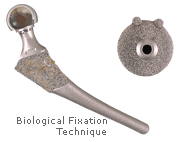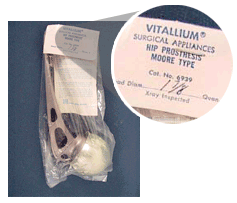Designing the Shape and Structure
Designing a Hip
The hip joint consists of two parts. The femur, the bone in the thigh, supports the pelvis.
The rounded head of the femur fits into a cup-shaped "socket" called the acetabulum. This "ball and socket" joint allows quite free motion in many directions.
The joint itself is surrounded and supported by tendons and ligaments, and lubricated by the body's synovial fluid.
The First Generation
The Moore implant, right, and Thompson implant, far right, were both designed in the early 1950s. They replaced the head of the femur, but used the patient's own acetabulum.
These designs are still used today for patients who have fractured the neck of the femur. They are both held in place with bone cement, but the "windows" in the Moore replacement allow the patient's bone to grow through.
A Revolution in Hip Implants
In the late 1950s and early 1960s, Sir John Charnley, a very innovative British surgeon, developed many of the techniques which made total hip replacements reliable.
In order to reduce friction in the joint, he reduced the size of the replacement head for the femur. He also replaced the patient's acetabulum with an artificial "socket" made of metal lined with teflon and later, when it was discovered that teflon released irritating particles as it wore, with polyethylene. The implants were held in place with bone cement rather than plates and screws.
Müller Total Hip Replacements
These replacements designed in the mid-1960s built on Sir John Charnley's discoveries. They used a cobalt-chromium alloy implant in the femur and a high-density polyethylene replacement for the acetabulum. Both parts were held in place with bone cement.
The small metal strips in the plastic parts ensured that they could be detected with x-rays.
Porous Coating
The "bumpy" surface on this hip replacement is the result of a new breakthrough made in the 1970s: biological fixation.
In this technique, parts of implants are coated with tiny metal balls with spaces between them. The patient's own bone grows into the spaces, interlacing bone and metal to hold the new joint solidly in place.
This type of replacement is now favoured for younger patients, while joints attached with bone cement tend to be used for older patients.
The "Latest Thing"
One of the major changes to hip implants in recent decades has been the use of new materials. Hip implants are now available with ceramic heads, often attached to lightweight titanium alloy shafts.
How Big are Your Hips?
One challenge in designing a joint replacement is to ensure that it will fit the wide range of human sizes and shapes.
Older replacements, like the Moore implant shown here, were made in one piece, but came in a range of sizes.
Today, many replacements are designed to have separate "mix and match" parts. This makes it possible to customize the replacement to suit the patient's individual proportions and needs. The shaft shown here is exceptionally long, designed specifically for patients who have already had one implant and are now "replacing the replacement".
| Look at knee replacements |
| View early designs for hip replacements |

